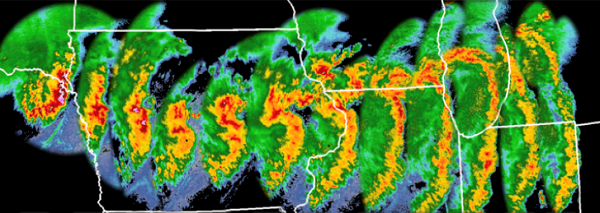Are Severe Thunderstorms REALLY Severe?

What Classifies a Severe Thunderstorm?
Severe thunderstorm warnings are issued by your local National Weather Service office, and in a given year a single office might send out more than a hundred of them. A severe thunderstorm is defined as a storm capable of producing a tornado, winds of 58 mph or more, and/or hail of at least 1” diameter. A thunderstorm that produces one-inch hail is a severe thunderstorm, but it may not produce any damage to a house or car…maybe to a field of soybeans. To a farmer, this severe thunderstorm is damaging, but to a city or suburban dweller it is a false alarm.There is a discussion that maybe we should have “escalating” severe thunderstorm warnings along these lines:
- This is technically a severe thunderstorm, but it’s unlikely to damage much
- This is a severe thunderstorm and many people can expect some damage
- This is a REALLY severe thunderstorm that could kill you
What is a "derecho?" Does it Count as a Severe Thunderstorm?
On August 10, 2020 parts of South Dakota, Nebraska, Iowa, Illinois, Wisconsin, Indiana, Michigan and Ohio got an honest-to-goodness #3 when a devastating “derecho” windstorm blasted its way across 700 miles of corn, soybeans, homes, trees, businesses and apartments. Straight-line winds of hurricane force were produced by this severe thunderstorm complex, killing four people and causing billions of dollars in damage, so this was a storm you definitely wanted to be alerted for. Here’s how it looked on radar, hour-by-hour:
The bowing of the thunderstorm line is caused by severe winds pushing it forward. An apartment complex in Cedar Rapids, Iowa had its roof torn off and some walls were knocked down, indicating winds of 140 mph; the equivalent of a strong tornado. Elsewhere in Iowa millions of acres of near-perfect corn were mowed down by winds officially measured at 126 mph, equal to a Category 3 hurricane. In some areas, the wind blew continuously at hurricane strength for more than thirty minutes.
A huge severe thunderstorm complex that continues for many hours, covers hundreds of miles of territory and produces widespread wind damage is called a “derecho” from the Spanish word meaning “straight ahead”. In other words, these damaging winds don’t swirl like a tornado or hurricane, they plow pretty much straight forward.
Some refer to the August 10 derecho as an “inland hurricane”, because of its hurricane-force winds. I think “derecho” is a good enough term, because this storm did not rotate like a hurricane does. We have had true “inland hurricanes” before, but instead of being a line or a blob of severe storms, they circled around, and were spinning somewhat like a hurricane does. This derecho on May 8, 2009 truly earned the term “inland hurricane” because it developed its own “eye” as its storms rotated around:

Why Should You Set Your Weather Radio to Receive Severe Thunderstorm Alerts?
Inland hurricane or derecho, millions of people who felt the effects of this monster storm now know not all Severe Thunderstorm Warnings are created equal, and some of them can be truly life-threatening. I agree it is a bother to have a weather radio go off for a Severe Thunderstorm Warning when you get nothing more than a gusty breeze and some small hail, or maybe not even that. You may complain about being over-warned, but I would remind you that over-warning is an inconvenience. Under-warning can be deadly.If you want to limit the number of alerts you receive on your desktop weather radio, you may do so by accessing the MENU and using its EVENTS features. The “biggee” events like Tornado Warning, Hurricane Warning, Civil Emergency Message, Nuclear Power Plant Emergency and many others are “locked in” and are inaccessible. You can certainly use the EVENTS menu to turn off Severe Thunderstorm Warnings, but as a meteorologist I do not recommend it. Several people lost their lives on August 10 after a Severe Thunderstorm Warning had been issued for their area a half hour earlier. Had they heard and understood this strongly worded warning, they might not have been where they were when they died:

Bruce Jones
Meteorologist/Spokesperson
Midland Radio Corporation
Kansas City, Missouri, USA


